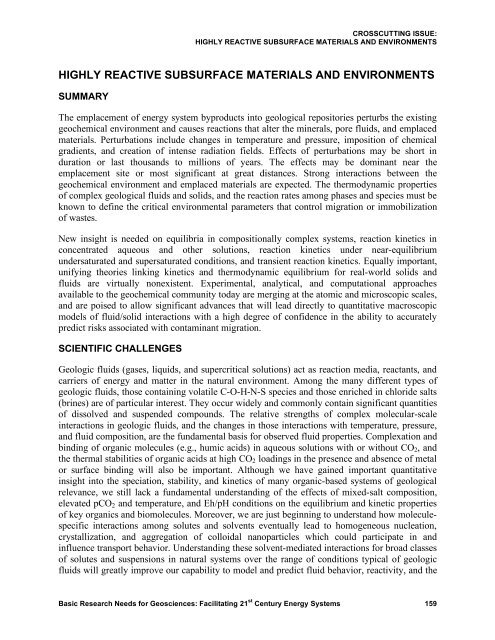Basic Research Needs for Geosciences - Energetics Meetings and ...
Basic Research Needs for Geosciences - Energetics Meetings and ...
Basic Research Needs for Geosciences - Energetics Meetings and ...
- No tags were found...
Create successful ePaper yourself
Turn your PDF publications into a flip-book with our unique Google optimized e-Paper software.
CROSSCUTTING ISSUE:HIGHLY REACTIVE SUBSURFACE MATERIALS AND ENVIRONMENTSHIGHLY REACTIVE SUBSURFACE MATERIALS AND ENVIRONMENTSSUMMARYThe emplacement of energy system byproducts into geological repositories perturbs the existinggeochemical environment <strong>and</strong> causes reactions that alter the minerals, pore fluids, <strong>and</strong> emplacedmaterials. Perturbations include changes in temperature <strong>and</strong> pressure, imposition of chemicalgradients, <strong>and</strong> creation of intense radiation fields. Effects of perturbations may be short induration or last thous<strong>and</strong>s to millions of years. The effects may be dominant near theemplacement site or most significant at great distances. Strong interactions between thegeochemical environment <strong>and</strong> emplaced materials are expected. The thermodynamic propertiesof complex geological fluids <strong>and</strong> solids, <strong>and</strong> the reaction rates among phases <strong>and</strong> species must beknown to define the critical environmental parameters that control migration or immobilizationof wastes.New insight is needed on equilibria in compositionally complex systems, reaction kinetics inconcentrated aqueous <strong>and</strong> other solutions, reaction kinetics under near-equilibriumundersaturated <strong>and</strong> supersaturated conditions, <strong>and</strong> transient reaction kinetics. Equally important,unifying theories linking kinetics <strong>and</strong> thermodynamic equilibrium <strong>for</strong> real-world solids <strong>and</strong>fluids are virtually nonexistent. Experimental, analytical, <strong>and</strong> computational approachesavailable to the geochemical community today are merging at the atomic <strong>and</strong> microscopic scales,<strong>and</strong> are poised to allow significant advances that will lead directly to quantitative macroscopicmodels of fluid/solid interactions with a high degree of confidence in the ability to accuratelypredict risks associated with contaminant migration.SCIENTIFIC CHALLENGESGeologic fluids (gases, liquids, <strong>and</strong> supercritical solutions) act as reaction media, reactants, <strong>and</strong>carriers of energy <strong>and</strong> matter in the natural environment. Among the many different types ofgeologic fluids, those containing volatile C-O-H-N-S species <strong>and</strong> those enriched in chloride salts(brines) are of particular interest. They occur widely <strong>and</strong> commonly contain significant quantitiesof dissolved <strong>and</strong> suspended compounds. The relative strengths of complex molecular-scaleinteractions in geologic fluids, <strong>and</strong> the changes in those interactions with temperature, pressure,<strong>and</strong> fluid composition, are the fundamental basis <strong>for</strong> observed fluid properties. Complexation <strong>and</strong>binding of organic molecules (e.g., humic acids) in aqueous solutions with or without CO 2 , <strong>and</strong>the thermal stabilities of organic acids at high CO 2 loadings in the presence <strong>and</strong> absence of metalor surface binding will also be important. Although we have gained important quantitativeinsight into the speciation, stability, <strong>and</strong> kinetics of many organic-based systems of geologicalrelevance, we still lack a fundamental underst<strong>and</strong>ing of the effects of mixed-salt composition,elevated pCO 2 <strong>and</strong> temperature, <strong>and</strong> Eh/pH conditions on the equilibrium <strong>and</strong> kinetic propertiesof key organics <strong>and</strong> biomolecules. Moreover, we are just beginning to underst<strong>and</strong> how moleculespecificinteractions among solutes <strong>and</strong> solvents eventually lead to homogeneous nucleation,crystallization, <strong>and</strong> aggregation of colloidal nanoparticles which could participate in <strong>and</strong>influence transport behavior. Underst<strong>and</strong>ing these solvent-mediated interactions <strong>for</strong> broad classesof solutes <strong>and</strong> suspensions in natural systems over the range of conditions typical of geologicfluids will greatly improve our capability to model <strong>and</strong> predict fluid behavior, reactivity, <strong>and</strong> the<strong>Basic</strong> <strong>Research</strong> <strong>Needs</strong> <strong>for</strong> <strong>Geosciences</strong>: Facilitating 21 st Century Energy Systems 159
















